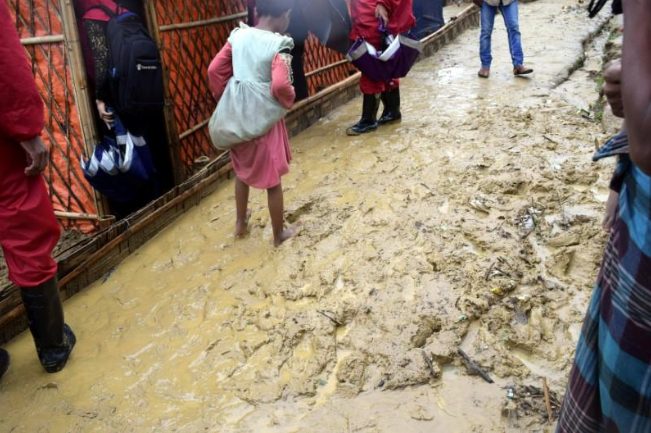Refugee children: living in limbo between two worlds
Children are always among the most vulnerable in any humanitarian emergency. This is especially true in the world's largest refugee camp in Cox's Bazar, Bangladesh – home to 886,000 people from Myanmar, more than half of whom are children.
As a humanitarian aid worker focused on child protection, I recently served in the camps for several months. My days were unnerving, filled with images I won't soon forget.

Young girls told me about their fears of being attacked while using the unlit latrines at night. Many adolescent girls and women are unable or unwilling to leave their shelters even during the day due to harassment and abuse. Their fears are rooted in being or knowing gender-based violence survivors.
Boys face dangers, too. I saw adolescents – cut and bruised, some shoeless – returning from collecting firewood in the forest, where they encounter snakes and other wild animals. They hoist heavy bushels onto their shoulders for the long walk back, ever afraid of getting lost in the labyrinth of pathways in the overcrowded camps.
These children have survived or witnessed horrific violence. More than 200,000 need psychosocial support, according to the Inter-Sector Coordination Group (ISCG). In the camps, children tell us that they live in constant fear of being assaulted or separated from their families. They face health risks, too. Without adequate access to safe water and sanitation facilities, they are vulnerable to diseases such as diphtheria and acute watery diarrhea. Many suffer from malnutrition; thousands are engaged in child labour. All are deprived of a formal education.
Such dangers and threats are not new to these children and their families. The international community describes the Rohingya people as one of the world's most persecuted minorities. Their rights have been consistently violated for decades, leading to the mass exodus of 700,000 people from Myanmar beginning in August 2017. Today, they live in limbo between two worlds. They are denied citizenship and recognition at home in Myanmar, and are not officially recognised as refugees in Bangladesh.
The Government of Bangladesh is not a party to the 1951 Refugee Convention. However, it has ratified the UN Convention on the Rights of the Child. This means that all children in Bangladesh, regardless of origin, are afforded equal rights. Yet birth registration for refugee children born in the camps – 60 a day on average – is currently on hold. Some are excluded based on legal status or the origin of their parents. Without identity cards, these children face a lifetime of proving who they are. If they are lost or separated outside the camps, family tracing and reunification will be difficult. And without legal documents, they are easy prey for traffickers and vulnerable to illegal child marriages. To protect the future of these children, the government should be urged to restart birth registration for those born in the camps.
Children also need immediate access to education. While some educational activities are ongoing in the camps, an estimated 530,00 refugee children age 3-17 years are missing out on formal education. Government restrictions prevent any formal or non-formal education programmes from being offered to the refugees, and girls face additional obstacles in accessing education, including cultural and traditional constraints.
Informal education can only go so far. It cannot adequately build children's resilience to enable them to reach their full potential. Children want to be in school, as they and their caregivers told me repeatedly. There is a clear link between increased access to education and child protection. Quality education in times of crises helps prevent all forms of discrimination and gender-based violence, and bring girls and boys closer to realising their equal rights.
When G7 leaders met earlier this month in Canada, their agenda included advancing the education of women and girls, and the ongoing crisis in Myanmar. Canada, along with the European Union, Germany, Japan, the UK and the World Bank, announced an investment of £2.2 billion, marking a fundamental shift toward improving access and reducing barriers to quality education worldwide. The announcement represents the single largest investment in education for women and girls in crisis and conflict situations. To ensure that refugee children in Cox's Bazar benefit from this incredible generosity, I hope that the G7 members will encourage the Government of Bangladesh to allow all children in the camps to access formal education.
Education for displaced children in crises makes a life-long difference. I've seen the fruits of this. When I returned home from Bangladesh, I watched the documentary I Am Rohingya: A Genocide in Four Acts. The film follows a group of Rohingya youth – former refugees now living in Canada who are enrolled in post-secondary studies – as they re-enact their flight from violence in Myanmar and Bangladesh. The documentary crystalises the power of education to change lives. These adolescents created a platform to share their stories and advocate for the hundreds of thousands of children in those two countries still caught between two worlds.
On World Refugee Day, let us honour the courage and tenacity of these Rohingya youth and the 65 million refugees worldwide, opening our hearts, minds and communities to them.
Vanessa Saraiva is a child protection technical specialist with World Vision.
To donate, or find out more about World Vision's Myanmar-Bangladesh Refugee Crisis appeal, click here











